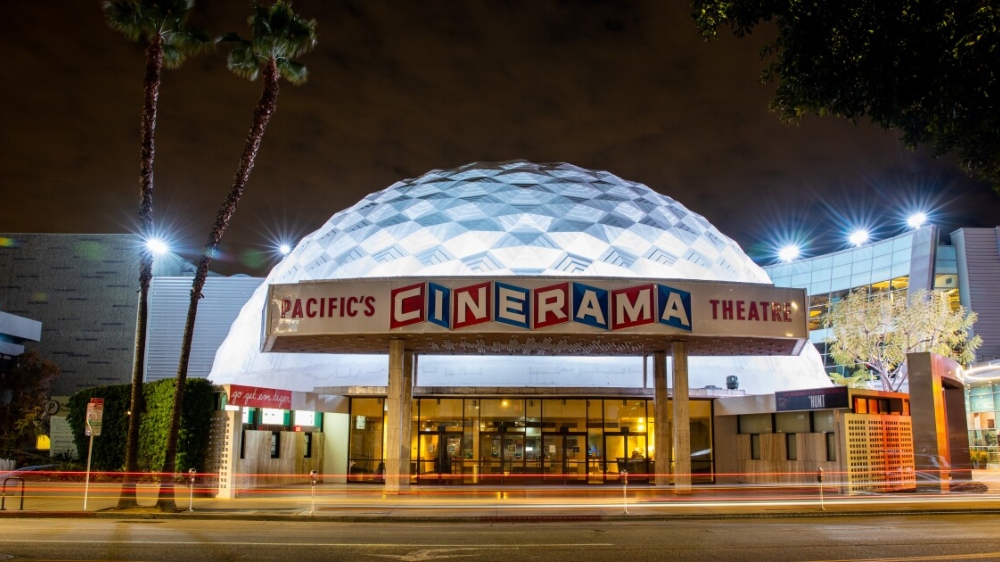
The 12-screeen Landmark Pico theaters was a hub of moviegoing — art films and blockbusters alike — for 15 years. But COVID-19 thinned out the crowds and when Landmark was unable to come to an agreement with the landlord, Landmark Theatres president Kevin Holloway was forced to announce its closure at the end of May. Everyone who loves going to the movies, especially those living on the Westside, mourned its demise, just as they did the iconic Cinerama Dome and 15 other ArcLight locations that closed in 2021.
In 2020, the National Association of Theatre Owners (NATO) pleaded with Congress to add movie theaters to the Save Our Stages relief initiative in the next COVID bill, stating that, without help, 70 percent of the theaters in the U.S. could file for bankruptcy or close permanently by the end of the year.
As COVID-19 continues to wax and wane, it’s time to look at the messy and complicated business of movie exhibition. While Top Gun: Maverick may have been the first billion-dollar movie of Tom Cruise’s long career, movie theaters are still navigating a difficult time. At CinemaCon this past April, NATO president John Fithian touted the box office success of such releases as Spider-Man: No Way Home, which, he said, “delivered historic grosses.”
Yes, a handful of blockbusters did very well during the pandemic, but earlier this year on Jan. 7, Gallup revealed that “Americans watched an average 1.4 movies in a movie theater over the past 12 months,” compared to the average 4.8 they saw between 2001 and 2007. In the past 12 months, Gallup found an “historic high” of 61 percent of Americans who did not visit a movie theater at all, compared to 32 percent between 2001 and 2007.

It would be easy to draw the conclusion that COVID has had a drastic impact on movie exhibition, but writer and industry consultant David Bloom believes that the overall picture is more nuanced.
“It’s not just about COVID,” said Bloom. “Even before the pandemic hit, revenues were going up only because the theaters charged more for tickets, and the number of people buying tickets was declining. For younger people in particular, movie-going as a regular habit was dropping and is continuing to drop.”
In fact, according to NATO’s data, the high mark for the number of cinema sites was 1996, with 7,798; in 2020, that number had fallen to 5,798. Media analytics company Comscore states that just under 12 percent of theater sites shut down just before COVID-19; half of which had three or fewer screens, with rural areas and small cities hit particularly hard. When theaters reopened, fewer consumers than ever went inside.
Movie multiplexes often anchor malls and, notes Bloom, malls — weakened by e-commerce — are in dire straits now, especially the “B or C-level” malls. In pre-pandemic 2020, Coresight Research predicted that 25 percent of the U.S.’s 1,000 malls would close by 2025; multiplexes attached to such malls would thus lose all their foot traffic.
Another complicated issue with its roots unrelated to COVID is the challenge of feeding theater chains with enough content; Bloom states that “there aren’t enough movies in the pipeline for all their screens.” One reason has been Hollywood’s shift from mid-budget movies (in the $10 million to $70 million range) to blockbusters based on established franchises. Over 20 years ago, Hollywood discovered that action-adventure movies with little dialogue translated to big box office numbers globally; international revenue has dominated box office grosses since 2003. Deadline just reported that, according to Gower Street Analytics, the international box office in 2021 “hit an estimated $16.9 billion, an increase of 66 percent over the previous year.” Those same blockbusters also do boffo box office in domestic theaters — but there aren’t enough of them to feed all the screens.
The videogame industry — which Bloom estimates is valued at four times that of the movie industry — is another factor weakening movie exhibition. Bloom points out that gamers stay at home for hours at a time gaming. In response, Hollywood continues to attempt to lure gamers to theaters with movies based on game franchises, but the results have been mixed. But it makes a lot of sense at a studio like Sony that has both a movie studio and a gaming division.

Sony PlayStation chief Jim Ryan announced that the company has ten movies based on gaming titles in the works. “We will continue to strengthen the experience for our community through collaboration with partners and across Sony Group,” said Ryan. “One especially noteworthy collaboration is in our ongoing work with Sony Pictures to adapt key game IP for film and TV entertainment.”
Streaming, of course, is another pre-pandemic piece of the puzzle. If international box office and videogaming decreased, respectively, mid-range movies and younger audiences, the advent of streaming changed how everyone viewed content. Netflix began streaming video in 2007, the same year it delivered its billionth DVD, another entertainment option that kept consumers at home. At the same time, TVs evolved from HighDef to 2K and 4K, with HDR (high dynamic range) and other bells and whistles. People fearful of catching COVID in a movie theater, said Bloom, “used their stimulus money to buy a 75-inch TV with a sound bar — and they’re OK with that.” According to Statista, 181 million Americans were streaming video by 2019.
Streaming dealt another blow to the movie exhibition business. Before home video became a reality with VHS, movie theaters could exhibit movies for six months without competition. With VHS, that “exclusivity window” shrank to 90 days.” Streamers that made their own original content felt no compunction about releasing it simultaneously in a few theaters and their streaming platform. Exhibitors felt the pain, and NATO fought for the return of the exclusivity window.
Since then, moviemakers, studios, and streamers have been searching for a way to do business that protects their own interests while being acceptable to the other parties. Disney gave Black Widow an exclusive theatrical release, moving its streaming date from May 7 to July 9. NATO’s Fithian called that a win, declaring that, “the simultaneous release is dead as a serious business model, and piracy is what killed it.” But distributors and movie exhibitors are still working on exclusivity windows, on a studio-by-studio basis and even on a movie-by-movie basis.
COVID is just the latest bump in the road for exhibitors, distributors and content creators. And it’s not a factor that will likely go away anytime soon. Bloom notes that recent research shows that the virus, which continues to evolve quickly, will come and go more like colds than the flu. “It’ll make it harder for people at risk to go out and see the smaller $20 million movies,” he said.
Meanwhile, streaming platforms have their own problems. Paying for Netflix, Amazon Prime, Disney+, Paramount+, Hulu and HBO Max is too much money and too much content for the average consumer. Some of the platforms are already pivoting to the idea of adding advertisements, live events, and other disruptive models. Although it might not be imminent, we will see a shakeout in this space; not every streaming platform will survive.
Movie theaters meanwhile have also been busy adopting other uses for their brick-and-mortar theaters, showing everything from opera concerts to live eSports games. Bloom predicts, however, that we’ll see “continued consolidation” in the movie exhibition space. “Private equity will do what it does for media sectors that are distressed and still throwing off cash,” he says. “They’ll buy out the smaller chains, roll them up, and extract as much as they can. I think it’ll be interesting to see how many theater exhibitors will continue to provide better chairs, better audio and better concessions to make it an experience.”





